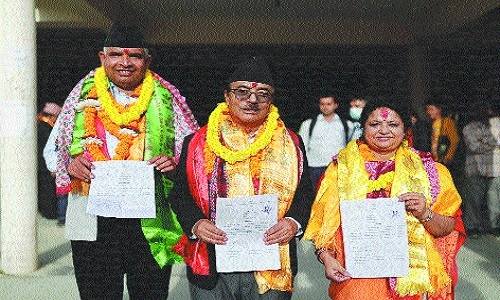Nepal’s tryst with democracy
| Date :26-Oct-2022 |

By ARUN KUMAR SHRIVASTAV
NEPAL is going to polls on November 20 this year for the second time in its latest tryst with democracy. The first round of general elections took place in 2017 after the country got a brand new constitution in 2015. What makes the Nepal elections an interesting political development in the land-locked country a little shy of 30 million people and $33 billion worth of GDP is the aspirations of the people from the new political system after living under a monarchy for the greater part of its modern history.
Unlike in many countries, elections in Nepal are a hotly debated and fiercely contested exercise. The new constitution gave rise to seven new provinces in Nepal. Earlier, it was divided into 70-odd districts and had a central rule. Now the elections on November 20 will elect 165 members for the House of Representatives of the National Parliament and 330 lawmakers for the provincial legislature.
The November 20 general election in Nepal has mostly the same old faces in the fray as in the 2017 elections. There are reports that Nepal’s election commission will be keeping a close watch on candidates’ electoral expenditure, with inputs that some are openly flouting the norms. Also, the cadre and comrade-based political movements, so far, are giving in to the pressures from their financers to concede them some party tickets. Gradually and through these elections, domestic politics which has so far been dominated by ordinary party workers and their leaders is letting ideology-free and profit-seeking businessmen become the new voice of their politics.
The current Prime Minister, Sher Bahadur Deuba, belongs to the Nepal Congress, while his immediate predecessor KP Sharma Oli was from CPN (UML). Besides these, there are at least five major political parties that are recognised at the national level and have varying degrees of influence in the country. Among them are CPN (Maoist-Centre) and CPN (Unified Socialist) with Pushpa Kamal Dahal and Madhav Kumar Nepal as the top functionaries respectively. Both have served as the Prime Ministers of Nepal in the past.
While these parties have a pan-national presence, some political parties champion the cause of the Terai regions (Himalayan foothills). These parties are the People’s Socialist Party-Nepal, Loktantrik Samajwadi Party, and People’s Progressive Party (Nepal) with Upendra Yadav, Mahanta Thakur, and Hridayesh Tripathi. The latter three are considered closer to India while the remaining four political parties try to balance their approach between India and China.
Given the many political parties in the fray and their respective vote banks, the last election did not produce any clear majority for any of the parties. As a result, there emerged two coalitions that kept making and breaking through the five years, and power changed from one coalition to another. The same is likely to be the case in this round of elections as well. And, the coalition politics seems to continue for at least the next five years, if not more.
For the people, elections provide a great talking point and that’s quite a relief given the 10-year-long civil war that saw the ultra-Left forces waging a war against the State and finally making way to the country’s political mainstream. Civil war crimes have still not been investigated and responsibilities fixed. Over 12,000 people were killed in the conflict that lasted from 1996 to 2006. For a lot of people in the otherwise peaceful Himalayan climes of Nepal, these deaths are unsettling memories. Elections bring a change in the social and political milieu.
But the average Nepali’s aspirations of prosperity are far from being delivered by the political dispensations so far. The country’s economy is over 30 per cent dependent on agriculture. There is a large presence of local and foreign NGOs given the ecological importance and sensitivities of the region. In the intellectual circles of Kathmandu which constitute NGO workers, staff of foreign diplomatic missions, university teachers, and journalists, the foreign donation is a big topic of discussion. But for the common Nepalis, it’s a job visa for a foreign location that does the trick. Manpower companies in Kathmandu sometimes have queues stretching up to 100 meters.
Often there are news reports in the local press about Nepali workers dying due to harsh climates or working conditions in the Middle East and elsewhere. For a lot of foreigners who have made Nepal their home, it’s ironic to watch the men and women from this beautiful country with bountiful natural resources migrate to the Middle East and such places to work for as low as $300 a month. But a strong political sensitivity against foreign interference doesn’t let Nepal benefit from the presence of economic powerhouses in its neighbourhood – India, and China.
Will the new elections throw up leadership that pulls the country out of its predicament is anybody’s guess. But the fact that Nepal, with all its colours and festivals, is now witnessing the festival of democracy gives one some sobering thoughts. (IPA)
n